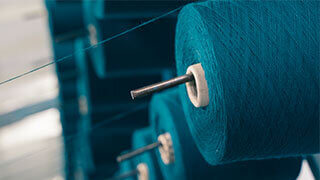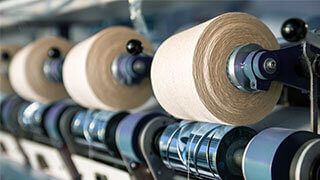Yarn Spinning Processes
Yarn Spinning
There are three different methods for spinning, or twisting, the prepared cotton fiber into yarn. These processes differ in the manner in which they insert twist, resulting in distinctly different yarn structures. The result of these different structures can be seen and felt in the final product.
Ring Spinning
Ring spinning is the oldest and most established spinning system. It is based on the very first yarn spinning methods ever employed and continues to be quite popular to this day. While it has changed little in principle, new ring spinning machines are a far cry from the earliest versions. Production rates are still low when compared to rotor, or open-end, and air-jet systems but the yarn quality is still the benchmark for even these newest, high-production systems. The ring spinning system still enjoys the widest possible yarn count range and excels at producing very fine counts. The hand (softness) of ring-spun yarn-produced fabrics is judged to be second to none.
The ring spinning process is quite simple. The roving is the input for the process and passes through a basic, and usually 3 roll, drafting system. After drafting, the fiber is twisted into a yarn structure by a whirling spindle, which has a removable bobbin on it. The winding of the yarn onto the bobbin takes place due to the traveler and ring combination. Thus the term ring spinning.
Ring spinning requires a subsequent winding step. That is, the full bobbins must be wound onto a cone or cheese to create a much larger package that is then usable for weaving or knitting. These additional steps of roving and winding, combined with the slow production rate (when compared to rotor and air-jet), are the primary reasons for the higher cost differences for ring-spun yarn.
Rotor Spinning
Rotor or open-end spinning came into widespread use in the late ’70s and early ’80s. It is still in use today and comprises a large percentage of the 100% cotton yarn spun in the United States. It is very fast when compared to ring spinning, up to 10 times the production per spindle. From a cost standpoint, it doesn’t require the roving process step and it does not require an extra winding step. Yarn is ready for use directly from the machine. The process today is highly automated and includes automatic piecing (restarting of broken ends) and doffing (removal of full packages). For these important economic reasons, rotor spinning became the yarn-making system of choice through the early ’90s in the U.S.
Yarn count range is somewhat limited when compared to ring spinning. Rotor spinning doesn’t perform well at much above Ne 40/1 and is really most productive in the yarn counts below Ne 20/1. More than 95% of denim yarn produced in the U.S. is made using rotor spinning.
The rotor spinning process is difficult to conceptualize. A sliver is used as the input and is fed into a small carding device called a combing roll (or opening roll). This individualizes the fibers and performs the drafting. The loose fibers are sucked into a rotating rotor cup where they are attached to the rolling, open-end of yarn found there, thus the name, open-end spinning. The yarn is withdrawn and the process becomes continuous.
Air-Jet Spinning
Air-jet spinning first appeared for production use in the early ’80s. It has continued to grow in its popularity, especially for cotton and polyester blend yarns.
The largest end-use market up to this point has been for sheeting and print cloth. Recent advancements in the latest generation of machines have made this high-production system more forgiving to shorter fiber length, and thus to cotton use. This has broadened the technology’s versatility and appeal to more end-use possibilities.
This spinning system uses sliver as its input, thereby taking advantage of the cost savings afforded by deleting the roving step required by ring spinning. Much like rotor spinning, it also produces a wound package that is ready for subsequent use in weaving or knitting. This negates the need for a separate winding step.
The air jet machine uses roller drafting as the means for reducing linear mass in the fed sliver. The drafting system is not unlike the drafting configuration found on the ring spinning system. After exiting the front pair of drafting rolls, the fiber is pulled into an orifice by a suction airflow created by the vortex that will perform the twist insertion. As the fiber enters the vortex zone, it is literally spun into a yarn structure by the whirling air currents. Like rotor spinning, there is some degree of random fiber entanglement that is also involved. This is the main reason for the somewhat lower yarn strengths of air jet yarns when compared to their ring spun counterparts.
Just as in rotor spinning, this process is highly automated with the automatic piecing of broken ends and automatic doffing (removal) of full yarn packages.
TERMS TO KNOW (click to flip)
The oldest and most versatile spinning system for short staple yarns offering the widest range of yarn counts. In ring…
view in glossaryA spinning process in which a rotating rotor is used to insert twist to the fed fibers.
view in glossaryA spinning system in which air is used to insert twist.
view in glossary

